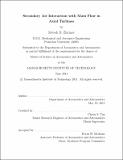| dc.contributor.advisor | Choon S. Tan. | en_US |
| dc.contributor.author | Zlatinov, Metodi B. (Metodi Blagoev) | en_US |
| dc.contributor.other | Massachusetts Institute of Technology. Dept. of Aeronautics and Astronautics. | en_US |
| dc.date.accessioned | 2011-11-18T19:30:18Z | |
| dc.date.available | 2011-11-18T19:30:18Z | |
| dc.date.copyright | 2011 | en_US |
| dc.date.issued | 2011 | en_US |
| dc.identifier.uri | http://hdl.handle.net/1721.1/67070 | |
| dc.description | Thesis (S.M.)--Massachusetts Institute of Technology, Dept. of Aeronautics and Astronautics, 2011. | en_US |
| dc.description | This electronic version was submitted by the student author. The certified thesis is available in the Institute Archives and Special Collections. | en_US |
| dc.description | Cataloged from student submitted PDF version of thesis. | en_US |
| dc.description | Includes bibliographical references (p. 155-157). | en_US |
| dc.description.abstract | Secondary air, known as purge air, is injected through seals in the hub and shroud of axial turbines to prevent hot gas ingestion into the endwall cavities. An investigation into the interaction of purge ow with turbine main ow has been undertaken, to determine where losses are generated, how they are generated, and what are the most eective ways for reducing them. The eect of purge ow design on the system's susceptibility to ingestion was also studied. Tools developed for accomplishing these objectives include: a consistent framework for isolating entropy generated due to viscous effects, a procedure for factoring out individual loss categories, and a linear model for secondary air ow response to the main flow pressure field. These tools, applied to steady computations, elucidate four routes through which change in loss generation is brought about by purge air injection: a shear layer between purge and main streams, modification of the secondary ow through the blade passage, an increase in degree of reaction, and the potential for reducing tip clearance ow (for the case of purge ow injected from the shroud). It was further determined that purge air mass ow and swirl velocity are eective parameters for mitigating loss, with a potential for 70% reduction in purge ow losses. By contrast, purge slot axial inclination and gap width do not affect the loss characteristics of purge ow by more than 6%. The benet of pre-swirling purge ow can be negated by decreased sealing effectiveness, if ingestion is driven by the pressure non-uniformity associated with the rotor upstream in influence. However for a representative vane-rotor stage, in which the vane-induced circumferential pressure non-uniformity dominates in the intra vane-rotor gap, pre-swirling purge flow can be beneficial to deterring hot gas ingestion. Finally a framework has been formulated for assessing the time-averaged impact of unsteady vane-rotor interaction on purge ow-induced loss generation. Preliminary results suggest that ow unsteadiness can result in substantially higher losses associated with purge flow injection. | en_US |
| dc.description.statementofresponsibility | by Metodi B. Zlatinov. | en_US |
| dc.format.extent | 157 p. | en_US |
| dc.language.iso | eng | en_US |
| dc.publisher | Massachusetts Institute of Technology | en_US |
| dc.rights | M.I.T. theses are protected by
copyright. They may be viewed from this source for any purpose, but
reproduction or distribution in any format is prohibited without written
permission. See provided URL for inquiries about permission. | en_US |
| dc.rights.uri | http://dspace.mit.edu/handle/1721.1/7582 | en_US |
| dc.subject | Aeronautics and Astronautics. | en_US |
| dc.title | Secondary air interaction with main flow in axial turbines | en_US |
| dc.type | Thesis | en_US |
| dc.description.degree | S.M. | en_US |
| dc.contributor.department | Massachusetts Institute of Technology. Department of Aeronautics and Astronautics | |
| dc.identifier.oclc | 758677984 | en_US |

